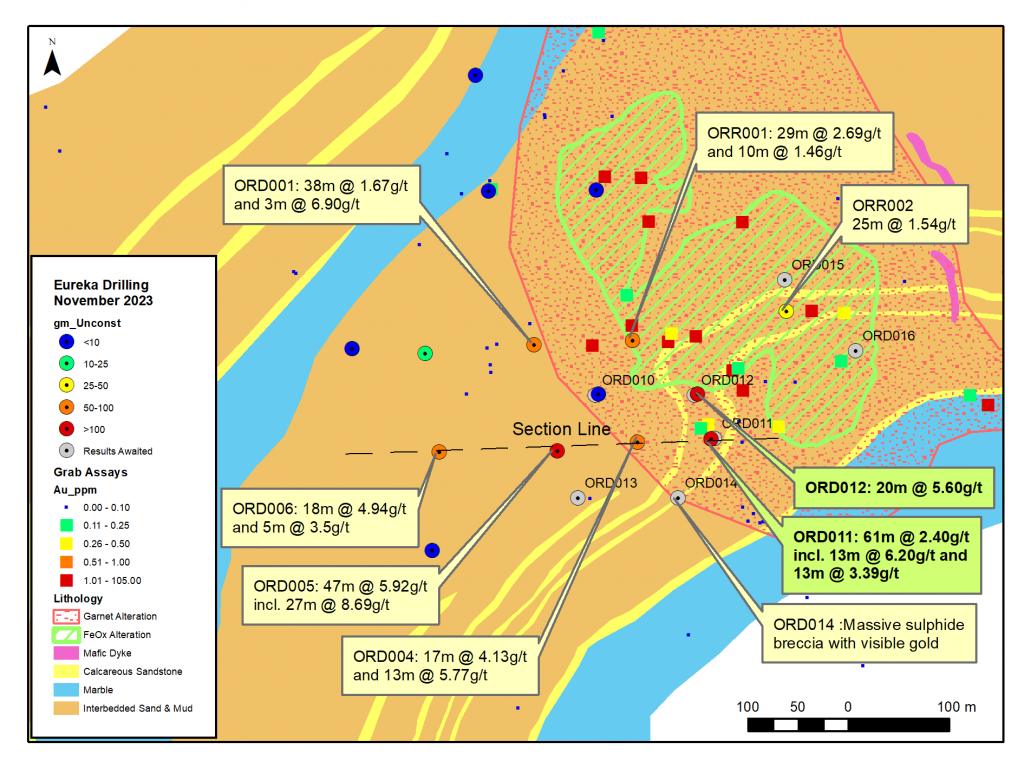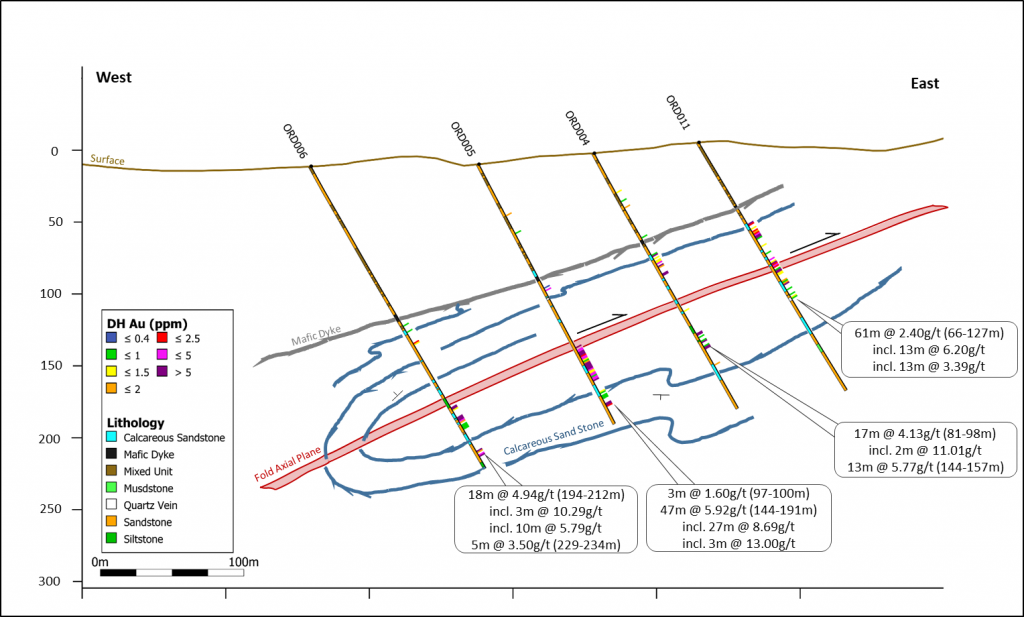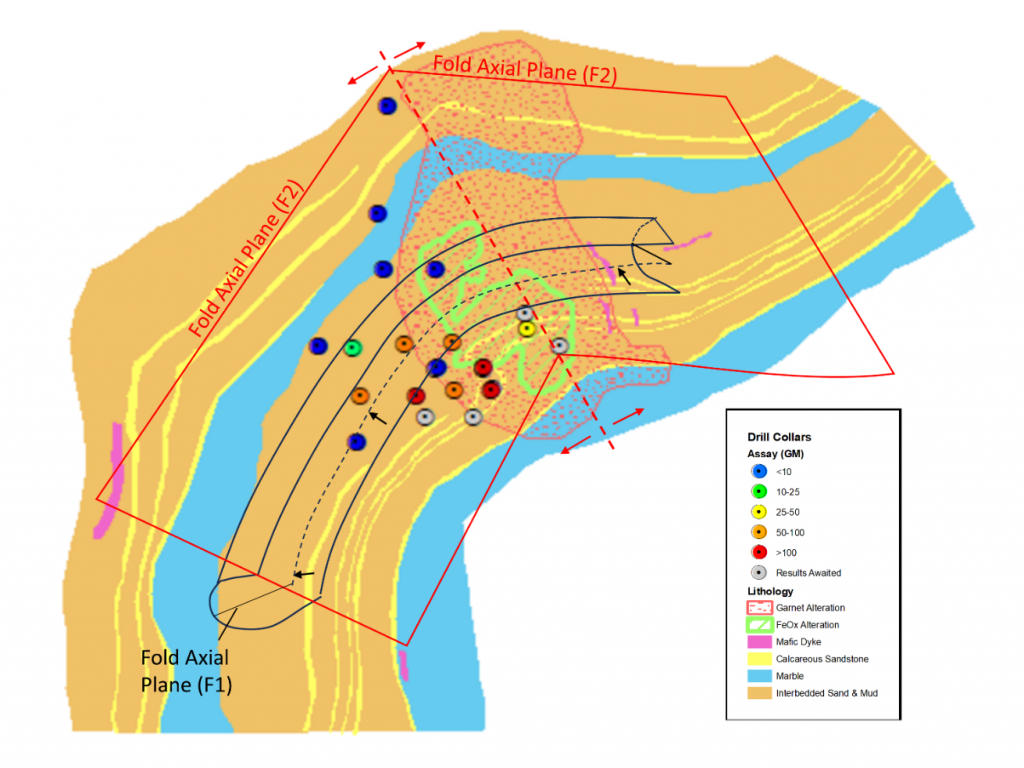
Osino Resources (TSXV:OSI) recently released an update on the ongoing Phase 2 drill program at its Eureka Project, which is focused on exploring and expanding the gold discovery initially reported on August 9, 2023. The current drill program, which began in late September 2023, has seen significant progress with five out of the planned seven holes, totalling 1,133 meters, already completed. There is a possibility of extending the drilling budget due to encouraging results from the ongoing step-out holes.
The drilling operations, comprising holes ORD010 to ORD014, were conducted on an azimuth of 090 degrees, targeting the area perpendicular to the strike of a parasitic fold identified on the surface. The subsequent holes, ORD015 and ORD016, are planned at an azimuth of 135 degrees, aiming to explore the geological formations east of this fold. These efforts are directed at testing the continuity of mineralization in areas marked by gossan and garnet alteration, as well as near the marble contact zone, where a recent rock chip sampling yielded an assay value of 12.1 g/t Au.
The Eureka Project is situated within the Okonguarri Formation of the Damara Supergroup. This geological setting is noteworthy as it is the same host rock that is found at the Otjikoto gold project of B2Gold Corp., located approximately 140 kilometres northeast along the same geological strike. The area’s lithology is characterized by a mix of interbedded sands, shales, mudstones, calcareous sands, and marble, all of which have undergone metamorphosis to greenschist facies. This geological complexity is further accentuated by multiple episodes of folding and faulting, contributing to the intricate structural formation of the region.
The current focus of drilling is a south-westerly plunging shoot, which has been intersected over an area of approximately 350 by 150 meters, with a variable thickness of 20 to 60 meters. This mineralized zone remains open to the west, south, and east and is primarily concentrated along a fault or series of faults on the axial plane of an overturned F1 recumbent fold. The complexity of the deposit is compounded by the re-folding of the F1 fold along a later F2 fold generation, enhancing the fracture system within the deposit.
The gold mineralization at Eureka is believed to have occurred in two distinct phases. The initial phase is associated with low-grade, bedding parallel quartz-carbonate veins, followed by a higher-grade phase in massive sulphide breccias along axial planar faults. The sulphide composition mainly includes pyrrhotite and pyrite, with traces of chalcopyrite. The most significant grade intervals are characterized by massive pyrrhotite and intense brecciation. Garnet alteration, particularly in finely interbedded sands and shales, is frequently linked with high-grade zones and serves as a key indicator for gold exploration in the region.

Dave Underwood, Osino’s VP Exploration commented in a press release: “We have now spent considerable time and effort on site doing fine-scale mapping and relogging core to interpret the results at this first Eureka target. The mineralization at Eureka is quite different to the company’s other deposits at Twin Hills and Ondundu, with its much higher gold grades associated with sulphide breccias and skarn alteration. The excitement is building within the team as we come to grips with what Eureka has to offer in terms of grade, scale and the potential for multiple deposits. The mineralization at Eureka is hosted within a calcareous sedimentary package which has seen at least two and possibly three episodes of complex folding and faulting. We are using oriented diamond core for all holes to try and unravel the geological puzzle and build a coherent lithological and structural model. The first hole in the second phase of drilling appears to have clipped the edge of the mineralization but the second hole (ORD011) went through a wide zone and returned 61m @ 2.40g/t Au from 66m down. The third hole intercepted a very high grade (20m @ 5.60g/t) interval to the north of ORD011, confirming the robustness of the mineralization.
The next two holes drilled to the south and southeast of previous work also show visual indicators of good mineralization including sulphide breccias and visible gold. We expect to receive these results before the end of November. The Eureka deposit is wide open to the east, west and south at this stage and there are strong indications in the magnetic data that there may be a second parallel shoot just 1km to the west.”

Future Exploration Plans
The company has outlined a comprehensive work program for the coming months at the Eureka discovery and its surrounding areas. Key components of this program include:
- Completion of the Phase 2 drilling and subsequent assaying, followed by an update to the geological and structural model.
- Execution of a detailed heli-borne magnetic survey, scheduled for late November 2023, to refine the five magnetic targets identified from regional magnetics and potentially uncover additional targets.
- Alteration mapping utilizing satellite and airphoto data.
- Expansion of step-out and infill surface geochemistry sampling programs, including exploration of new targets in the northern part of the license area, within the Kuiseb Formation Sediments.
- Additional delineation and step-out drilling planned for the first quarter of 2024.
- Follow-up mapping and rock chip sampling across the area, stemming from a comprehensive soil program.
- Scout drilling of magnetic targets, particularly focusing on pyrrhotite dominated mineralization due to its strong magnetic signature.
Highlights from the results are as follows:
- Eureka (Phase 2) step-out drill program consisting of seven holes for 1400m nearing completion, focussed on the first of five geophysical and surface targets in the area.
- Latest results received include:
- ORD011: 61m @ 2.4g/t Au incl. 13m @ 6.2g/t and 13m @ 3.39g/t (from 66m)
- ORD012: 20m @ 5.60g/t Au (from 75 to 95m)
- Detailed mapping on surface, combined with structural logging of the oriented diamond core, has enabled the team to build a preliminary lithological and structural model.
- Helicopter-borne magnetic and radiometric survey to be completed before end of 2023 designed to better define the remaining four primary geophysical targets for drill testing early in 2024.
- Results from the previous round of Eureka drilling include:
- ORD005: 47m @ 5.92g/t Au (144 – 191m) incl. 27m @ 8.69g/t Au and 3m @ 13g/t Au
- ORD006: 18m @ 4.94g/t Au (194 – 212m) and 5m @ 3.5g/t Au
- ORD004: 17m @ 4.13g/t Au (81 – 98m) and 13m @ 5.77g/t Au
- ORD001: 38m@ 1.67g/t Au (43 – 81m) incl. 3m @ 9.43g/t Au and 3m @ 6.90g/t Au
The above references an opinion and is for information purposes only. It is not intended to be investment advice. Seek a licensed professional for investment advice. The author is not an insider or shareholder of any of the companies mentioned above.
If you would like to receive our free newsletter via email, simply enter your email address below & click subscribe.
CONNECT WITH US
Tweets
Tweet with hash tag #miningfeeds or @miningfeeds and your tweets will be displayed across this site.
MOST ACTIVE MINING STOCKS
Daily Gainers
 Ratel Group Ltd. Ratel Group Ltd. |
RTG.TO | +60.00% |
   |
CZN.AX | +50.00% |
         |
AFR.V | +33.33% |
         |
RUG.V | +33.33% |
         |
GCX.V | +33.33% |
         |
CASA.V | +30.00% |
   |
SRI.AX | +28.57% |
         |
BSK.V | +25.00% |
         |
GZD.V | +25.00% |
         |
GQ.V | +25.00% |
Articles
FOUND POSTS
Arras Minerals (TSXV:ARK) Updates on Elemes Drill Program in Kazakhstan
December 19, 2024
Potential Trump Tariffs Could Reshape Copper Market Dynamics in 2025
December 17, 2024

 Follow us on Twitter
Follow us on Twitter Become our facebook fan
Become our facebook fan







